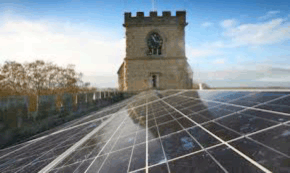Six Arenas
Sitting in front of a computer screen in the middle of another Zoom conference on climate change, the exuberance of the presenters is consistently tested by the scope of the legislative endeavors that must pass. The issue is not the cliché that “no bill is perfect,†which is true. Rather, climate change is a threat multiplier across every human activity and endeavor, and its footprint is global. A Green New Deal bill will accomplish much in the coming decade, but no one bill can anticipate nor address all the issues created by human output in the last one hundred years.
At present, we are on a baseline trajectory to raise the median temperature of the earth by 2100 +3.5oC (6.4oF). The baseline is the output of carbon we are experiencing today without any change or mitigation. Today’s baseline is unsustainable, and the result would be a planet with huge swaths of uninhabitable land and ocean by the end of the century. With the proposed legislation, we will continue to produce carbon, pumping the element into the water and into the air, but the goal is to control and reduce the carbon output to a sustainable +1.5oC (2.7oF).
M.I.T.’s Management Sustainability Initiative divides up the carbon reduction puzzle into six arenas:
- Energy Supply
- Transport
- Buildings and Industry
- Growth
- Land and Industry Emissions
- Carbon Removal
Our legislative endeavors need to force changes in each of these six areas. If all the areas are not addressed, even if only one area is ignored, we will be unable to reach our sustainable goal of +1.5oC (2.7oF). Each area requires a firm legislative shove, often more than one. What follows is an outline of what is contained in each arena and what must be done. Each bullet point requires new aggressive legislation.
Energy Supply
The big four carbon producers that must be reduced to as close to zero as possible are:
- Coal
- Oil
- Natural Gas
- Bioenergy (e.g. wood, wood pellets)
The energy producers that do not produce carbon are called renewables. They must take over as much energy production as possible:
- Solar
- Geothermal
- Wind
- Nuclear* (*renewable but not clean)
The lever that forces the energy supply to shift from coal/oil/gas to renewables is:
- Carbon price/Carbon Tax
We may also need a break-through technology that does not emit greenhouse gases. Several have been proposed but none will be available in the foreseeable future. Funding is through research and development.
- New Zero-Carbon Breakthrough
Transport
All forms of transportation (ships, planes, trucks, cars) must shift to,
- Energy Efficiency
- Electrification
Buildings and Industry
All mechanicals in buildings and the processes and machines for manufacturing must make the same shift as transportation.
- Energy Efficiency
- Electrification
Growth
Some parts of the world are already experiencing a slowdown in population from an exponential trajectory to a geometric one, although not all populations are decreasing. Economic growth as defined by Gross Domestic Product must also decrease. We need to aim for less people and less stuff, backing away from a growth model for economies.
- Population
- Economic Growth
Population tends towards self-regulating when education rates rise in general and when education policies specifically targeting women are implemented. The issues of less manufactured goods are partially addressed in “Right to Repair†laws that create longer-lasting products and the legal ability/capability to repair locally.
Land and Industry Emissions
While energy consumption is tackled above, the pollution generated by industry and agribusiness must all be addressed. Monoculture agribusiness must transform to soil-healthy processes that are not dependent on manufactured fertilizers, herbicides, and insecticides.
- Deforestation
- Methane, fertilizers, HTC’s, and PFC’s
Carbon Removal
The only known carbon removal technology available today is replanting what we have destroyed on land and in the ocean. We will need new technology to pull carbon out of the air, either enhancing natural removals or manually sequestering carbon. Such technology does not exist yet.
- Afforestation
- Technological Carbon Removal
Putting the Points Together
No one bill will address all these issues. Legislation that redirects agriculture hardly seems like a climate change bill but both monoculture farms and beef ranches are huge contributors to the carbon pollution matrix. Government investments in education lead to smaller households in the next generation, an education bill. Shifting government subsidies from coal, oil, and gas to renewables would address the most significant source of carbon production, which is a straightforward energy bill. One bus can remove sixty cars from the daily commute, which would be funded in a transportation bill.
Some solutions will require international treaties and corporate compliance. We should invest in research and development, which would have a side effect of reducing college costs as the Sputnik program did. Corporations are guilty of the worst carbon pumping crimes and they need to fundamentally change or be forced to change into implementors of solutions.
We must pass legislation that does not include wishful thinking. A breakthrough technology just around the corner, hydrogen-powered cars for example, is a fantasy. The technology solution is not around the corner, which is no surprise because we have not invested much in developing such an invention. New technologies require investment and time; we have given neither.
Final Word
Your head should be spinning. At the least, organizing the bullet points in one place presents a clear direction of what sorts of legislation and regulations we need in the next year. Every bill is battle and we need a lot of bills to become law.
We are asking our legislator allies to cover all these legislative areas when we cannot track them ourselves. Using the M.I.T structure, we can organize progress in each of the six arenas. This tracking helps us help our legislators stay informed and on-track, while keeping ourselves informed as best we can.
We can do this.




